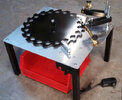.38 Special
Member
- Joined
- Sep 15, 2006
- Messages
- 7,355
The water quench is intended to prevent the base from getting too hot, which supposedly weakens it. It's one of those hoary old tales which have been passed down forever. I honestly don't know if it is true - I've never actually heard of a case failing because of too much annealing - but I'd hate to be the one who proves it, so I continue to be on the cautious side. I use a plain torch, hold the case in my fingers, and rotate the shoulder in the flame until it it just begins to glow orange in a dim room. This normally takes about a five count - I'm sure it depends on how hot the torch is, and where in the flame you are holding the case - and then I drop it into a water bucket before the base gets too hot to hold. This has always worked for me, and as I am a low-volume rifle shooter I see no need to spend money on the project. (Some people prefer to stand the case in a half-inch of water while running the torch around the shoulder. This supposedly guarantees against overheating the base, but I find it clumsy myself.)
There is, for what it is worth, there is a fellow here who argues quite strongly that this sort of traditional method is a waste of time and accomplishes nothing. He seems quite knowledgeable about metallurgy, and I can't rebut any of his points except by noting that when I am making significant changes to the case - necking down wildcats, for example - or even just trying to extend the life of expensive and//or rare cases, my old and primitive technique clearly and objectively works.
There is, for what it is worth, there is a fellow here who argues quite strongly that this sort of traditional method is a waste of time and accomplishes nothing. He seems quite knowledgeable about metallurgy, and I can't rebut any of his points except by noting that when I am making significant changes to the case - necking down wildcats, for example - or even just trying to extend the life of expensive and//or rare cases, my old and primitive technique clearly and objectively works.





